May 20, 2024 | 17:03 GMT +7
May 20, 2024 | 17:03 GMT +7
Hotline: 0913.378.918
May 20, 2024 | 17:03 GMT +7
Hotline: 0913.378.918
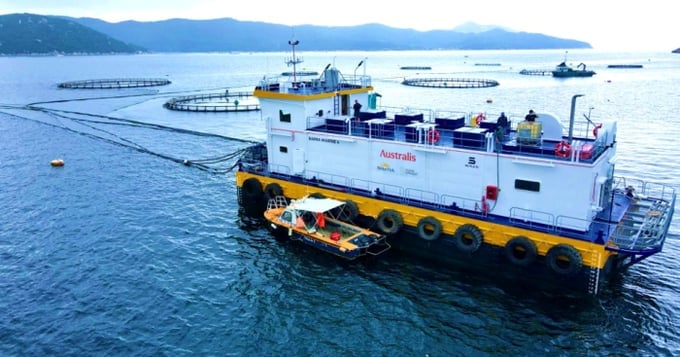
A 250-ton automated feed barge was launched by Australis on the afternoon of April 25 at Van Phong Bay, Khanh Hoa province. Photo: Australis.
Mr. Leonardo Mata, Chief Scientist at Greener Grazing under Australis Aquaculture Vietnam Limited, believes that Vietnam's mariculture industry, with its immense potential and advantages, will reach a multibillion-dollar scale in the near future.
Regarding industrial-scale mariculture, Mr. Leonardo Mata commented: "Australis Aquaculture Vietnam Limited was established in 2008 with an approximate total investment capital of 200 million USD. Its primary operations involve barramundi farming in Van Phong Bay, Khanh Hoa province. With over 15 years of mariculture experience, Australis Vietnam currently employs over 1,000 workers and aims for an annual growth of approximately 50,000 tons of aquatic products. The company constitutes 7% of the total seafood export value of Khanh Hoa province, establishing itself as one of the most modern mariculture companies in Vietnam."
As the earliest foreign investor in Vietnam's mariculture industry, Mr. Leonardo Mata affirms that Khanh Hoa province, as well as other favorable regions such as Kien Giang and Ninh Thuan, possess significant advantages for mariculture due to their stable temperature and salinity levels, which are suitable for the development of barramundi, otherwise known as the "tropical salmon."
In addition to the diligent work ethic and mariculture experience of the Vietnamese farmers, the market for barramundi products is growing in terms of attractiveness thanks to their high nutritional value. Mr. Leonardo Mata is confident that Vietnam's mariculture industry have the opportunity to achieve high-tech development goals in the near future, thereby making a substantial contribution to the value of the fisheries sector.
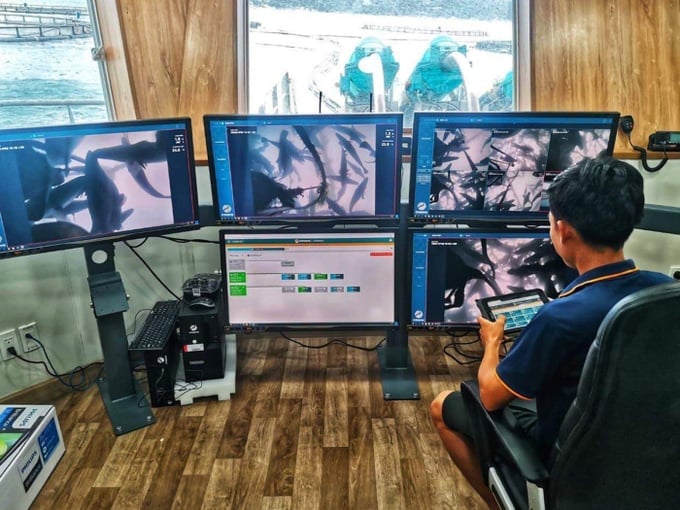
Sustainable development of high-tech aquaculture can yield nearly 10,000 tons of fish per year. Photo: Australis.
"Australis Vietnam is currently the world's largest producer, processor, and exporter of barramundi. Our strategy involves investing in technical research, recruiting foreign experts, training management personnel, and developing international markets for barramundi, thus establishing a comprehensive supply chain from production to market. Furthermore, we focus on upgrading modern offshore mariculture technology, using sustainable feed ingredients, monitoring barramundi development with advanced technology to ensure healthy and stable growth," shared Mr. Leonardo Mata.
During President of the United States Joe Biden's visit to Vietnam in 2023, Australis Vietnam committed to invest an additional 100 million USD in expanding sustainable barramundi farming in Vietnam. This significant milestone reflects Australis' ambition to develop mariculture in Khanh Hoa province, and subsequently expand the industry to other favorable mariculture regions.
Scientists at Australis selected barramundi (scientific name: Lates calcarifer) as their primary research subject due to its nutritional efficiency and high economic value. Furthermore, there is minimal environmental impact associated with the barramundi farming process. Consequently, Vietnam can emerge as a global player in barramundi farming with sufficient funding for industrial-scale mariculture and the application of modern science to mariculture. Accordingly, Vietnamese "tropical salmon" will have the opportunity to compete with salmon from developed countries such as Norway.
Australis Vietnam's development strategy has allowed the company to rapidly approach the 10,000 tons milestone for barramundi production in Van Phong Bay. After extending the marine area leasing permit in Khanh Hoa province, the company plans to implement a mariculture project in Kien Giang province. Consequently, Australis can fulfill its goal of producing 50,000 tons of barramundi per year as soon as its projects are fully operational.
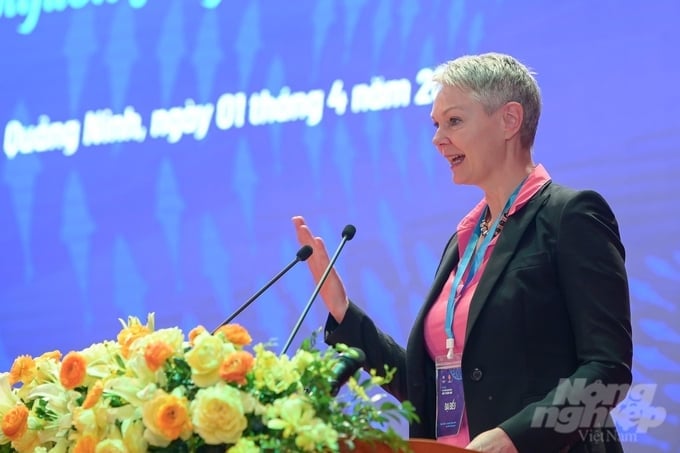
Ms. Hilde Solbakken sharing Norway's mariculture experience at the Sustainable Mariculture Development Conference - Insights from Quang Ninh. Photo: Tung Dinh.
In addition to its economic value, industrial-scale barramundi farming possesses advantages in terms of climate change resilience, and environmental and marine biodiversity protection. Australis Vietnam's Greener Grazing project, which functions as an industrial-scale barramundi farming model, aims to incorporate the cultivation of the Asparagopsis, a species of red algae. The combination between algae and barramundi farming has been regarded as a solution for environmental restoration. Another prominent candidate for intercropping with barramundi includes the Kappaphycus. Notably, this red algae has the ability to attract a significant number of herbivorous fish species, thereby reducing emissions and promoting sustainable farming practices.
Moreover, the algae-barramundi intercropping model can slow down the ocean acidification process, regenerate and enhance the sustainability of marine ecosystems, and absorb a significant amount of carbon.
"In order to foster sustainable mariculture development, with a focus on modern industrial-scale mariculture models similar to that of Australis Vietnam, we strongly recommend stakeholders to create a balance between various factors, and enhance biosecurity solutions in mariculture. The protection of the marine ecosystem will require concerted efforts from state management agencies, business communities, cooperatives, and farmers. Additionally, we recommend the Vietnamese government to facilitate the licensing process for mariculture businesses," suggested Mr. Leonardo Mata.
According to Ms. Nguyen Thi Hai Binh, CEO of STP Group, the company is currently researching and applying scientific and technological solutions to promote sustainable mariculture and environmental protection. Regarding aquaculture infrastructure, STP Group consistently updates and improves its products, with a focus on catering to specific farming practices across different regions and species, to provide fishermen with optimal utility value.
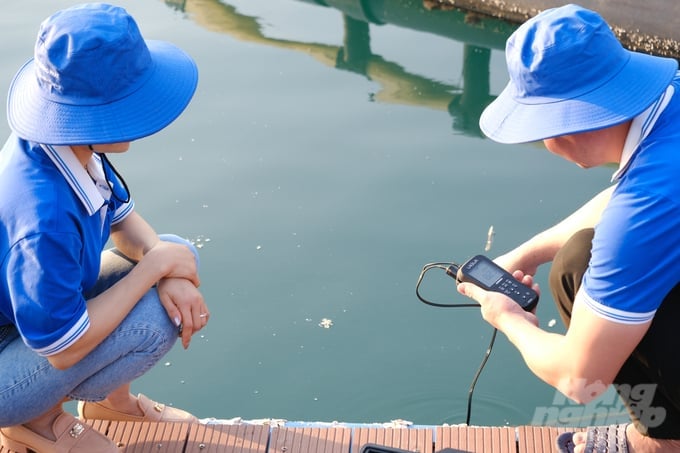
Inspection of the water parameters at STP's aquaculture area in Van Don Sea. Photo: Tung Dinh.
STP Group currently offers four models of HDPE floating cages, including square cages for fish farming in freshwater, brackish water, and marine areas within a range of 3 nautical miles; circular cages for multi-environment fish farming, preferred for offshore farming due to their higher productivity with larger cage volumes; rectangular cages and cluster rectangular cages for large-sized marine fish farming; and infrastructure floating cages. Notably, these HDPE cages are easy to assemble, operate, expand, and repair. Additionally, they are available in various sizes, and suitable for different aquatic environments.
STP Group has collaborated with the Phat Co Cooperative ,located in Van Don district, Quang Ninh province, since 2017 to establish an aquaculture and tourism integrated model. The model features a pre-engineered building with an HDPE float system, which provides accommodation for local farmers. Most notably, the company employs AI automation technology for its aquaculture operations, such as automated net cleaners and feeding systems. These AI-powered solutions aim to reduce labor, thereby increasing productivity and economic value.
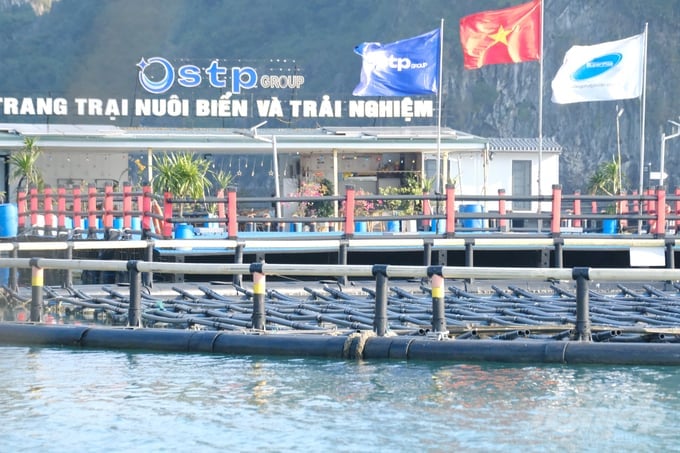
STP's aquaculture and ecotourism experience farm. Photo: Kien Trung.
"The automated feeding technology and AI-powered cameras help us analyze the fish's feeding behavior to minimize excess food. Environmental monitoring devices, equipped with German-manufactured sensors, continuously measure and record the aquatic environment in real-time, which help us identify which environmental factor affect the fish. In the event of oxygen deficiency, oxygen-supplying fans will automatically activate to replenish oxygen for the aquatic animals. Early detection devices allow us to predict the blooming of algae, and prevent potential harm to the fish. These devices are installed in various farming areas to establish a Big Data system for each region. Consequently, different facilities can select medication suitable for their aquaculture operations.
Regarding the intercropping approach, STP Group is currently combining algae farming with oyster and marine fish farming. The multi-species, multi-layer approach enhances mutual support and rapid growth. As the algae grows, its outer cellular layer (biological membrane on the algae) is continuously shed to promote growth. This biological matter serves as an excellent food source for the oyster's development. By combining two species, the water purification capacity is also significantly improved," shared Ms. Hai Binh.
Translated by Nguyen Hai Long
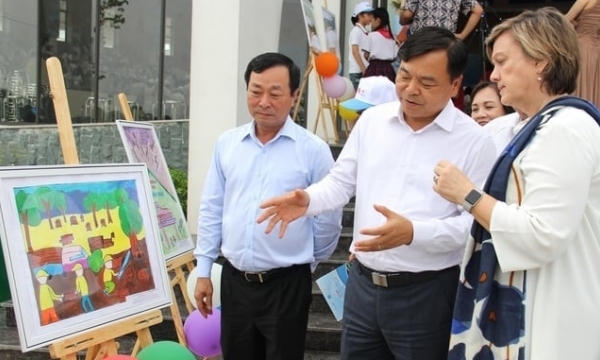
(VAN) According to Deputy Minister Nguyen Hoang Hiep, anticipatory action is a new approach in disaster management, with the aim of enhancing disaster prevention and preparedness.
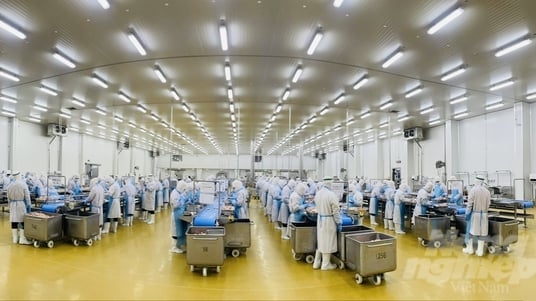
(VAN) The Ministry of Agriculture and Rural Development, in coordination with Tay Ninh Provincial People's Committee, organized a conference on May 18 to promote the export of animals and animal products.
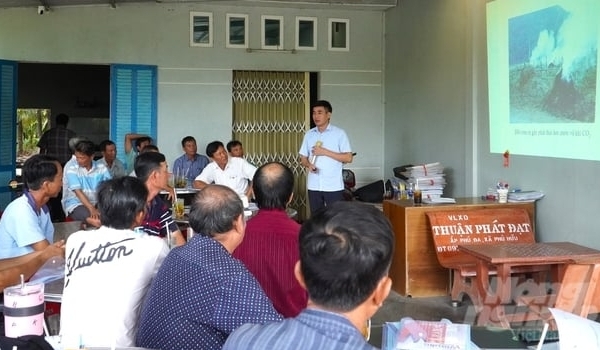
(VAN) From May 17-23, the National Agricultural Extension Center (NAEC) conducts training classes on the advanced rice farming process at 5 localities piloting for the 1 million ha of high-quality rice scheme.
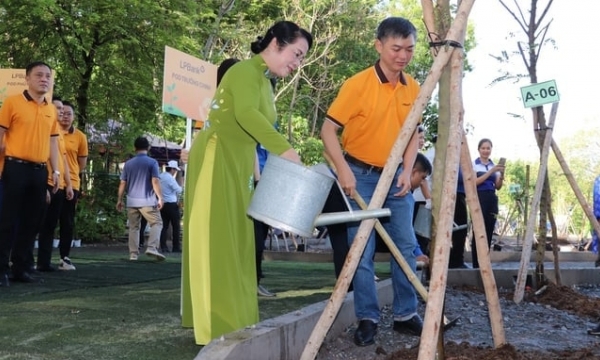
(VAN) Planting and expanding green spaces is a crucial effort to mitigate and adapt to the impacts of climate change, thereby creating a clean and livable environment.
/2024/05/17/5720-1-134847_782.jpg)
(VAN) EcoTraceTech - System for measuring CO2 and CH4 emissions from rice plants is the startup idea of a group of Can Tho University students.
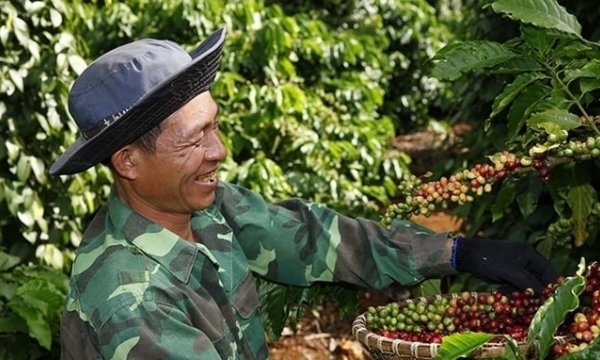
(VAN) The NESCAFÉ Plan by Nestlé Vietnam in the Central Highlands together with MARD aims to support coffee farmers in regenerative agriculture.
/2024/05/16/4437-1-223910_491.jpg)
(VAN) The Community Food Garden model is one of the outstanding activities and models of green transformation in the world as well as in Vietnam.